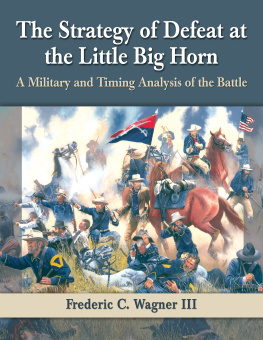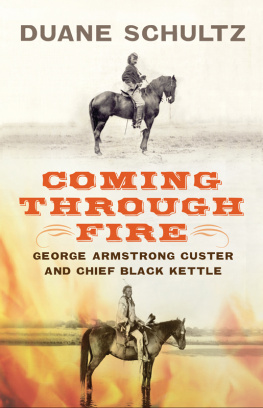Also by FREDERIC C. WAGNER III
Participants in the Battle of the Little Big Horn: A Biographical Dictionary of Sioux, Cheyenne and United States Military Personnel (McFarland, 2011)
The Strategy of Defeat at the Little Big Horn
A Military and Timing Analysis of the Battle
Frederic C. Wagner III

McFarland & Company, Inc., Publishers
Jefferson, North Carolina
All photographs were taken by the author unless otherwise indicated.
LIBRARY OF CONGRESS CATALOGUING DATA ARE AVAILABLE
BRITISH LIBRARY CATALOGUING DATA ARE AVAILABLE
e-ISBN: 978-1-4766-1881-4
2014 Frederic C. Wagner III. All rights reserved
No part of this book may be reproduced or transmitted in any form or by any means, electronic or mechanical, including photocopying or recording, or by any information storage and retrieval system, without permission in writing from the publisher.
Cover image: Custers Last Command Richard Luce (from the collection of Francis X. Young and the artist)
McFarland & Company, Inc., Publishers
Box 611, Jefferson, North Carolina 28640
www.mcfarlandpub.com
To my wife, Lisa,
with whom all things are possible,
and whose love, understanding and patience
made this book not only possible,
but necessary.
Acknowledgments
In any work of this nature, one needs the help of others, and in any work of this nature, when one is married, the principal assistant is generally ones spouse, if for no other reason than simple forbearance. In my case, my wife Lisa has been everything anyone could ask for: a cheerleader, an assistant, a listener, and most of all a young woman full of understanding, love, encouragement, and enthusiasm. Without her, nothing I have ever done about the Little Big Horn would have seen the light of daynothing. If custom did not dictate otherwise, her name would appear above mine, in larger letters, on the books cover. When you read this work, remember who drove it home; if you need to blame someone, blame me; if you want to spread credit, think of my lovely wife.
While my wife is my driving force, my daughterDori Eldridgemade the book possible by her incredible map-work. Dori had never tackled the difficulty of maps and contour lines, symbols and insets, but her brilliant abilities as a photographer and her adeptness at Photoshopping (Dori could turn a rock into Saturn with its rings) made my ideas a reality.
Those come from all over the place and many came from five friends I meet up with on the battlefield, every odd-numbered year. They are unusual men because we all met on the Internet, then got together and have been hard-and-fast buddies ever since. We have lived and re-lived this battle hundreds of times, and we agree and disagree, then re-agree, then have a beer. Next to my wife, they are my inspiration and my dear friends: (alphabetically, so I do not have to buy the next several rounds) Frank Bodden, Gary Lemery, Scott Nelson, Michael Olson, and Michael Max Reeve.
When it comes to haunting the battlefield, most take a back seat to two marvelous people who have encouraged me and who have provided all sorts of data, much of it supporting various contentions as to horse speeds, distances and routes, and therefore form a core in my work on the timing studies in this book: Steve Andrews, a former Marine and Vietnam veteran, and Terry Craft, a marvelous woman who raises horses in Kansas. They have ridden the fields themselves and have provided me with many great photographs, as well as GPS mapping to confirmor denya number of my suspicions. Without Steve and Terry, much of what I have done would have been mere guesswork; with them, it has become certainty.
Another long-time Little Big Horn passionista is Diane Merkel, who, over the years, has always been supportive of my work. It was Diane who spurred me on to publish my various works, so whatever I do needs to be accompanied by the notation It was Dianes idea. Without Dianes encouragement this would have never been published.
The same thanks go to Bill Rini with whom I started all my timing businessunfortunately Bill went his own direction, though as I think about it now, our differences make for very good debate again, over that ubiquitous beerand Stephen Kryzk for opening my eyes to the reality of a more accurate tally of Native Americans living during the mid1860s. His exhaustive work seems much more realistic than the hypothesizing provided by long-distance guesstimates so many people back then relied on, many of which only served personal needs, much as today. Stephens insistence upon me giving proper credit to Kingsley M. Bray for having done most of the grunt-work is indicative of a friends humility. There are also many intangibles that go into an endeavor of this sort, especially regarding the Native Americans. Those intangibles lead one to conclusions and feelings of various kinds, a sort of insightful understanding of things out of ones normal ken. It allows a person to understand how others may act. Mary Lou Backus provided me with just such an emotional understanding through her marvelous writings on the American Indian. Without people like Mary Lou we can never appreciate properly those who have seemed alien to us. From the aspect of the warriors in this historic event, this book would have been highly stilted without her help.
Dale Kosman, one of the most avid and knowledgeable aficionados of anything to do with the Little Big Hornincluding riding the trails in full woolen uniform in the stifling heat of summerhas patiently and consistently given me permission to use his remarkable photograph of my so-called, 3,411, the terrain feature I believe Custer stood on as he viewed the beginning of Markus Renos skirmish line fight. Dale took the picture from the valley floor and its clarity leaves me with no doubt 3,411 was Custers perch. Aside from his friendship and his ever-present smile, I thank Dale for his kindness. The same can be said of Michael Donohue, a summertime park ranger and the chairman of the Temple College Art Department. Mike is another man who never stops smiling, never stops laughing even when the laughter is at his own expense and is always there to help. The site of Marc Kellogs body has been a controversy over the years and even its present marker location on the battlefield irks many. Mike solved that riddle for me and because it came from him, I know it is true.
I would be remiss if I did not include a very heart-felt thanks to the fine artist, Richard Luce, who painted the magnificent picture gracing the cover of this book. Richards work is not only beautifully detailed; it borders on the spectacular for its grand, sweeping depictions of battle. I own a print of this beauty, but whenever I want to see the real thing I head to the home of a dear friend, Frank Young, a brother of my sister-in-law, who bought the originalunfamiliar though he may have been with the battlesimply because of its grandness. My thanks go to both Richard and Frank; I feel privileged to be a part of this painting.
Gregory Shelton of the United States Naval Observatory provided me with data helping me form opinions and develop the time/motion studies. Without that data we would be less certain of everything, and along with the accounts of two officers with Custer and the U.S.N.O.s data, I became convinced of the time standard the Seventh Cavalry utilized.
I met Don Horn several years ago, having heard the name but knowing little about the man. Since then, Don and I have become friends and he has provided me with pictures and notes, letters and books we battle ideas and we bore each other with stories. At least, I bore Don with mine; his are way too good to bore anyone. He is a link to the last of those who knew the characters in the play. His knowledge is invaluable and I have been graced by his friendship.
Next page



